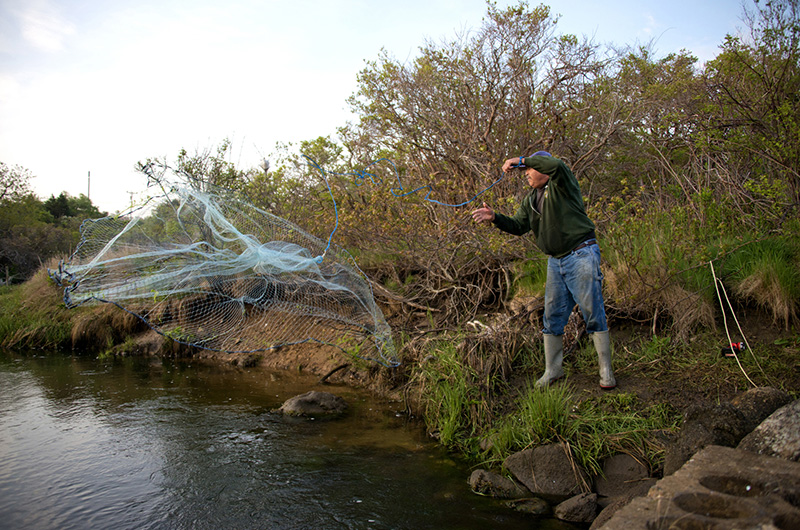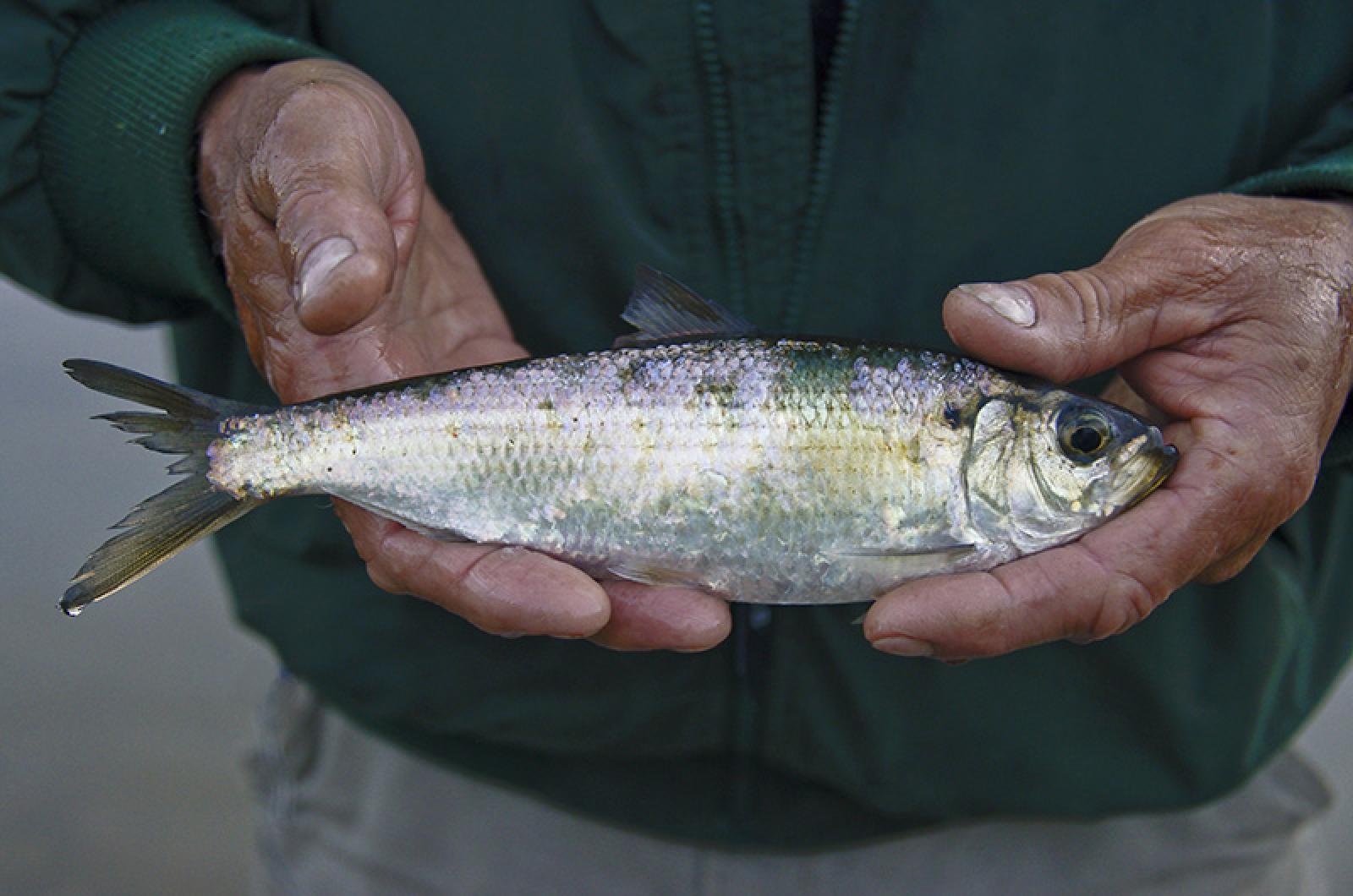Spurred by a recent collapse in the Atlantic herring stock, the New England Fishery Management Council voted last week to limit both the scope and size of the commercial herring catch for the next three years.
The amendment, which still has a number of government hurdles to clear before it becomes law, would ban large commercial herring vessels, also known as midwater trawlers, from fishing closer than 12 nautical miles from shore. It also includes an unprecedented ecosystem control rule meant to help replenish the stock of bait fish around the Cape and Islands.
The decision has been hailed by conservationists and independent fishermen who have been working for four years to pass regulations to help ensure the long-term sustainability of forage fish.
“This is the first time ever ecosystem management is being used to keep forage fish in the waters to help predators,” said Zach Cockrum, the northeast director of conservation partnerships at National Wildlife Federation. “We’ve been talking about doing this for decades and this is first time we’ve actually done it. I’m hoping we can take care of the boom and bust that happens with forage fish. Hopefully the population will stay a bit more stable.”
Herring are a foundation of the North Atlantic marine food chain. Not only are the oil and energy-rich school swimmers prey for the Vineyard’s larger, pelagic fish, like bluefish and striped bass; they also help support marine birds and mammals, including osprey, whales, dolphins, tuna and seals. Some scientists have speculated that they are the largest animal by biomass on the planet. But because they spawn in estuaries and coastal waters, including many Vineyard ponds, aggressive offshore trawling can cut off their migratory routes and threaten the population.

According to the 2018 herring stock assessment from the Northeast Fisheries Science Center, biomass in the North Atlantic has reached historic lows. American spawning had its sixth-worst year on record in 2017 and has decreased every year since 2011. The study also showed that there are now currently more six-year-old herring than one and two-year-old herring combined. Scientists fear that a dearth of young fish poses a grave threat to an already at-risk and rapidly fluctuating population.
“Herring has this incredibly important role as prey,” said Erica Fuller, an attorney for the Massachusetts Conservation Law Foundation. “So the question is how are you going to set catch limits so you have healthy predators?”
Herring are the only forage fish on the Atlantic seaboard managed with quotas set to preserve the long-term health of the stock. Over the past five years, the herring catch limit has been set at over 100,000 metric tons. But with the 2019 stock in peril, the federal government had already lowered that number to 24,553, and now with the new control rule voted on by the fishery management council last week, that number will shrink to 18,980 metric tons. In total, the control rules are set to lower the herring catch by 14,000 metric tons over three years.
The other part of the amendment creates a 12-nautical mile buffer zone that runs from the Canadian border to Connecticut, including Martha’s Vineyard and Nantucket. Midwater trawling will be prohibited within that protective zone year-round.
“We pushed for 50 miles, so 12 is obviously a lot less,” said Mr. Cockrum. “But the steps they took are major first steps not just for herring but for forage fish in general and managing them because of their importance to the ecosystem.”
The science remains foggy about what precipitated the collapse in a herring stock that was deemed healthy just four years ago. Independent fishermen have pointed to the increased presence of midwater trawlers in the North Atlantic as a potential cause. The trawlers use large, cone-shaped nets to drag through ocean waters at medium depths. In addition to herring, they often come back with larger pelagic bycatch like tuna.
“There’s no proof that overfishing caused the collapse,” Ms. Fuller said. “But there is also no proof that overfishing didn’t cause the collapse. There are no older fish and younger fish are reaching sexual maturity earlier. These are just indications that this population is very stressed.”
Although conservationists and fishermen believe the vote marks a major step toward replenishing the Atlantic herring stock, smaller hurdles remain before it crystallizes into law. After the council completes a final environmental impact assessment and writes the proposed rules, there will be an opportunity for public comment. If the rules pass the comment stage, NOAA, the federal agency in charge of American fishing regulations, will then have a vote to approve the decision.
“A lot has to still happen,” Ms. Fuller said. “And my guess is that it will be nine months to a year until we see any of these measures on the water.”
While most New Bedford commercial herring fishermen and a few mainland lobstermen who use herring as bait oppose the regulations, believing that the council’s effort to shrink the already dramatically decreased catch limits will squeeze them dry, the regulations have received almost unanimous praise from Vineyard conservationists and the independent fishermen who depend on its waters for their livelihood. The effort reflects a rare show of unity and the culmination of a nearly 20-year effort between two groups often at odds with one another.
“In the early 2000s, a bunch of people, advocates from different organizations who do not normally get along — the commercial tuna fleet, the recreational fleet, the environmental advocates — found we were all united on this one thing,” said Patrick Paquette, the government affairs officer for the Massachusetts Striped Bass Association. “If you deplete the bait source, all of our fisheries suffer.”
Since the turn of the millennium, Mr. Paquette has worked with recreational fishermen throughout southeastern Massachusetts to preserve the region’s bait fish population. He was a member of a group called CHOIR, founded in 2002 to advocate for the responsible development of the Atlantic herring fishery in the face of a growing fleet of midwater trawlers.
“I saw these trawlers out there and they looked bigger than Gillette Stadium,” Mr. Paquette said. “Wherever these guys fish there is a depletion problem with the forage fish.”
The trawlers generally range between 150 and 200 feet long, but often fish in pairs with one larger net strung between the two boats. Mr. Paquette, who has fished almost every day of the Martha’s Vineyard Striped Bass and Bluefish Derby since 1995, wasn’t alone in thinking that they were potentially responsible for not just the depletion in herring stock, but a dropoff in bluefish and striped bass as well.
Aquinnah charter captain and independent fisherman Buddy Vanderhoop agreed. “Fishing on the Vineyard just isn’t the same,” he said. “I ran a Gay Head Wampanoag herring run for 43 years. We fished three days a week, only took what we could manage, and we let the rest run. It was thriving until the midwater trawlers came into the picture.”
While he is in favor of passing the regulations, Mr. Vanderhoop feels that they don’t go far enough.
“The buffer should be more than 12 [nautical miles] by my estimation,” he said. “It’s a very tiny step in the right direction. Once you take away the forage fish, you don’t have any of the larger pelagics at all. The striped bass are suffering. The tuna are suffering. The whales are suffering. It’s having a really adverse effect on the fishing here.”
As a younger man, Mr. Vanderhoop and his brother Chip would sell herring as bait to up-Island fishermen. They called the fish “bass-candy,” and remember when the first herring stock crashed in the late 1970s. Russian trawlers crossed the Atlantic and exploited herring runs on America’s Eastern seaboard. Although herring have recovered since then, largely because of the retreat of Russian trawlers, the 48,147 metric-ton biomass measured in 2017 marks the lowest number since the Reagan administration controlled the White House.
“It’s enough to piss off the Pope on Palm Sunday,” Mr. Vanderhoop said. “The decline happened so drastically and was very, very noticeable. I’d like fishing to be as good for me as it was good for my grandson, and it’s looking pretty grim.”
Although Mr. Paquette has similar reservations about the extent of the regulations, he believes anything more drastic than what was voted on would be an unrealistic limitation on a commercial fishing industry already facing serious threats to its own livelihood.
“My perspective is that I don’t live in a utopian society where I get to run the world,” Mr. Paquette said. “These businesses exist, and in the U.S. we won’t just shut down a business because people don’t like it. So I hesitate to say it does enough, but I do think it makes the situation much better. And this was a monstrous achievement for a community of otherwise strange bedfellows. I think we will be in better shape because it was done when it goes through.”
The Martha’s Vineyard Fisherman’s Preservation Trust also hailed the vote. “I know this is just the first part, but it’s really exciting to see a multi-year effort so promising for conservation and independent fishermen,” executive director Shelley Edmundson said. “The midwater trawlers are indiscriminate and huge, and that’s not what we endorse. So it gives hope.”
Whether the regulations go through remains the question. Mr. Paquette is confident.
“It’s not over,” he said, “but the largest hurdle and the largest win have been done. We still have to get the federal approval . . . I feel these will. But I’m a fisherman, so by nature that makes me a little bit greedy.”







Comments (4)
Comments
Comment policy »